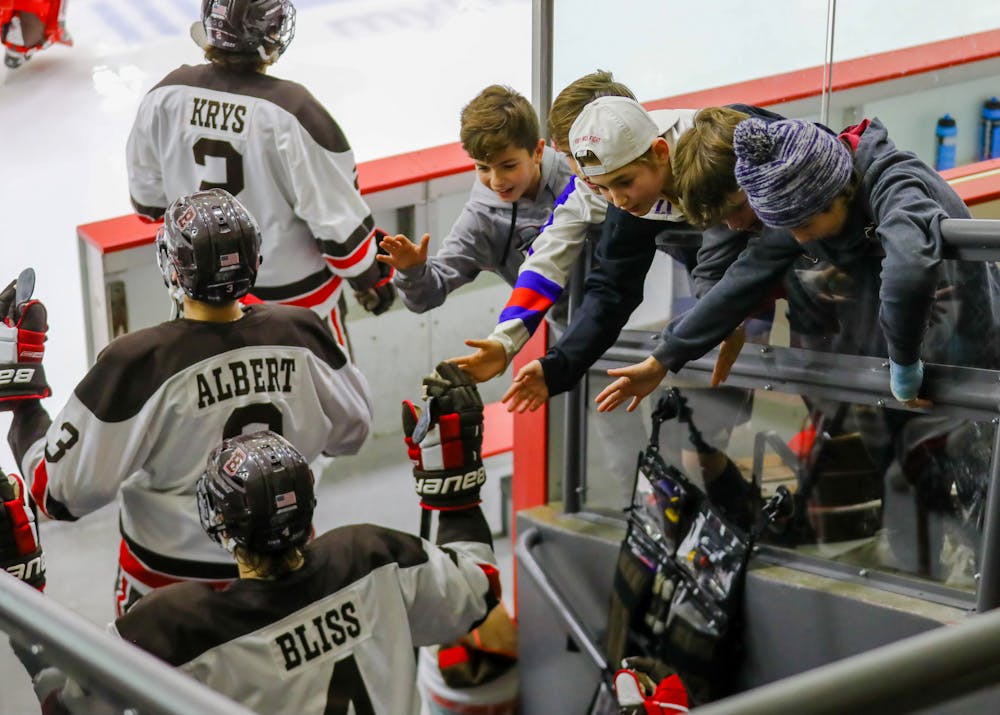On March 10, Brown Athletics published its “Division of Athletics and Recreation Strategic Plan,” a vision that Vice President for Athletics and Recreation M. Grace Calhoun ’92 PhD P’26 P’26 called a “promotion of (Brown’s) open curriculum concept” in University athletics.
The plan identifies five strategic priorities: competing with distinction, broad participation supporting campus wellness, growth through holistic development and sport performance, community engagement and investments in community members through infrastructure and resource optimization.
Calhoun, who arrived at Brown in March 2021, said the plan has been in development since her earliest conversations with President Christina Paxson P’19 P’MD’20.
“There was a lot of outreach to me with perspectives. … (I was) just getting a broad sense of where things were and what people would like to see going forward,” Calhoun said. “Once we established (a shared vision), we could start talking about the pieces to get to that shared vision.”
The strategic plan’s first priority centers around striving for excellence in varsity and club sports. The plan lays out a variety of benchmarks for success, including finishing in the top half of the Ivy League for cumulative varsity championship wins.
“I sometimes say I’m probably the second-most competitive person on campus, the first one being the President,” Calhoun said. “We’ve put a five-year timeline on most of (these goals), knowing that we’re building it for sustained success.”
In the case of earlier successes, “we’re gonna build more aggressive goals,” and where success lags, “we will go back and reassess” the plan, Calhoun said. “It’s gonna be this living, breathing document that constantly gets better.”
The priority also emphasizes the importance of recruitment in the success of varsity teams and includes data analysis to better evaluate trends in prospective students and alums. The “true measure of success” is bringing in students that will thrive both at Brown and beyond, “leading lives of impact and fulfillment,” Calhoun said.
While Calhoun emphasized the value of strong on-field performance, she also noted the importance of fostering increased participation supporting campus wellness — the plan’s second strategic priority.
On the plan’s second priority — broad participation — Calhoun said she hopes to “enhance the Brown experience to make it as meaningful as possible,” regardless of a student’s level of athletic participation. Part of this effort includes supporting greater conversations around nutrition, sleep recovery and mindfulness while also promoting the numerous existing programs and classes available to students seeking out athletic opportunities at Brown, including workout classes at the Nelson Fitness Center and intramural sports, she added.
Assistant Vice President for Athletics and Recreation/Governance and Performance Shoshanna Engel Lewis said that the plan’s focus on strengthening personal holistic development and sport performance — the third strategic priority — is “interdisciplinary and interconnected.”
Engel Lewis explained that the plan’s developers recognized that “there wasn’t necessarily a strategy to inform the lifecycle of wellness and performance from the time athletes were recruited until they graduate and beyond.”
After recognizing the need for a “stronger care model on the medical side” for varsity student-athletes, Engel Lewis said that the Athletics team “worked really closely with Health Services on the nutrition side, and (Counseling and Psychological Services) on the mental health side.”
This collaboration resulted in the creation of two new full-time positions for staff that would support varsity student-athletes: a sports dietitian and a sports psychologist, The Herald previously reported.
Engel Lewis hopes these new additions will provide access to professionals who “really understand Brown and also the experience of a Brown student-athlete” while strengthening partnerships with other campus partners and recognizing underutilized resources like the Mindfulness Center.
“We really thought, if this could come to life as an ecosystem — something that is continual collaboration — what we could accomplish is so distinctively Brown,” Engel Lewis added.
The plan’s fourth strategic priority highlights community engagement, both in person and on social media.
“Social media for us is not necessarily the business-like button-down approach, it’s supposed to be fun,” said Kelvin Queliz, associate director of athletics, strategic communications and content creation. “It’s not necessarily just, here’s a score, here’s a graphic, that’s it. How are we telling a unique story?”
“We’re trying to create experiences that become these goosebump, you’ll-never-forget experiences, because you’re with your fellow students supporting your school (and) having a great time,” Calhoun said.
Calhoun noted the importance of students in creating new traditions for Bears sports, highlighting the Brown Hype Squad, an organization founded by student-athletes with help from the Athletics Department.
The plan also touches on efforts to engage with the Providence community as a whole. One such initiative is Bruno’s Cub Club, announced last summer, which gives kids in 6th grade and under free tickets to a regular season game, a t-shirt and a birthday card.
“We want to get as many local youth as possible to feel like the Brown events are for them,” Calhoun said.
According to Calhoun, the plan’s fifth strategic priority to optimize athletic resources and infrastructure has the potential to “erase the divide between student-athletes and non-athletes.”
“Everyone should be an athlete on some level, just like everyone should be an artist on some level,” she said. “The beauty of Brown is that you can try a bit of everything … but everyone should feel included and welcome to try things.”
“I think it’s fair to say that students are more involved now than ever,” Calhoun continued. “But because we still want more to get involved, we know we’re going to have to address space concerns.”
Calhoun pointed to the Nelson Center renovations as an example of Brown Athletics “trying to use the space better to be able to accommodate more people effectively at once.” She also noted the development of the Nelson’s occupancy tracker which helps patrons better plan their workout windows and avoid the gym’s busier hours.
Calhoun also hopes to “take one of the classroom spaces (at the Nelson) and build it out with more weights” to create a “specialized room for people who might be new to weightlifting” to feel comfortable in that setting.
All five strategic priorities identified in the plan “work together,” Calhoun said.
“So while I think, as the athletic director, that peers of mine might say competitive success is the most important thing, I look at this and say all five goals work together,” she added. “We need success in all areas.”

Linus is a Sports editor from New York City. He is a junior concentrating in English, and when he's out of The Herald office you can find him rooting for the Mets, watching Star Wars or listening to The Beach Boys.

Sofia Barnett is a University News editor overseeing the faculty and higher education beat. She is a junior from Texas studying history and English nonfiction and enjoys freelancing in her free time.





